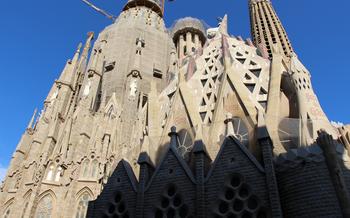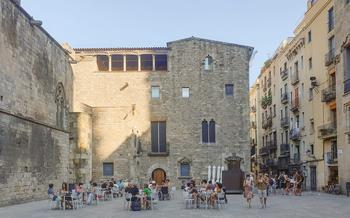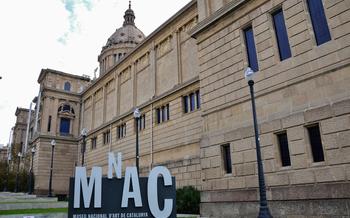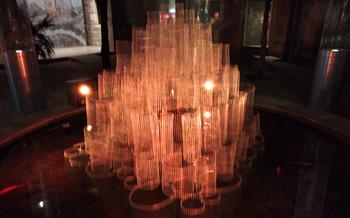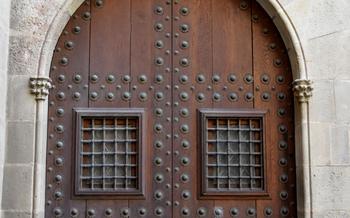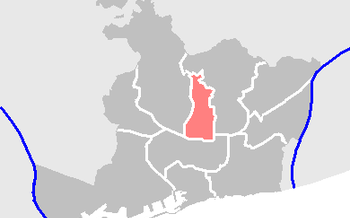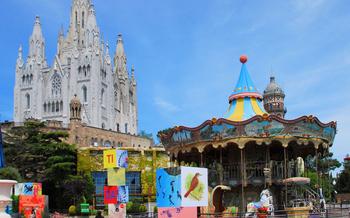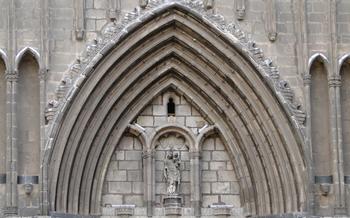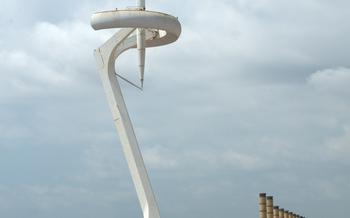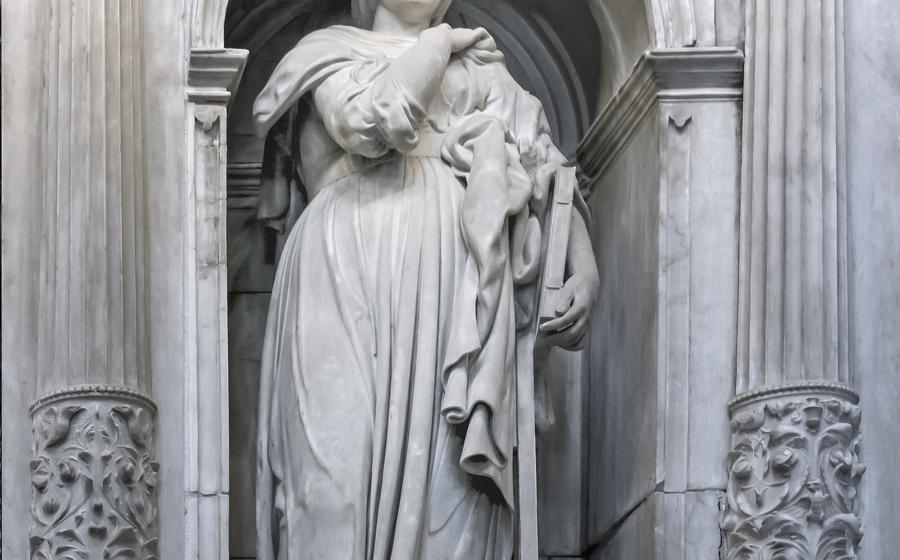
Barcelona Cathedral
- Barcelona Cathedral: A Gothic Masterpiece
- The Gothic Quarter: A Historical Neighborhood
- The Sagrada Familia: Gaudi's Masterpiece
- Las Ramblas: Barcelona's Bustling Boulevard
- The Picasso Museum: A Journey into the Artist's Life
- The Gothic Quarter: A Culinary Adventure
- The Montjuïc Magic Fountain: A Spectacular Light and Water Show
- The Barcelona Aquarium: Exploring the Marine World
- The Tibidabo Amusement Park: Thrills and Panoramic Views
- The Camp Nou Experience: A Football Fan's Paradise
- The Chocolate Museum: A Sweet Treat for the Senses
- The Maritime Museum: Unveiling Barcelona's Seafaring Past
- The MACBA: Contemporary Art in Barcelona
- Insider Tip: Discover Barcelona's Hidden Gems
Barcelona Cathedral: A Gothic Masterpiece
Barcelona Cathedral, officially known as the Cathedral of the Holy Cross and Saint Eulalia, stands as a testament to the city's rich history and architectural prowess. Its construction began in the 13th century, blending Romanesque and Gothic elements to create a unique and awe-inspiring edifice. The cathedral's imposing facade showcases intricate carvings, delicate pinnacles, and a grand central rose window, capturing the essence of Gothic grandeur.
Inside, the cathedral's vast interior unfolds, supported by towering columns and ribbed vaults that soar towards the heavens. The nave, with its elegant stained-glass windows, leads to the apse, where the intricate Gothic altarpiece, a masterpiece of Catalan art, takes center stage. Chapels radiate from the ambulatory, each adorned with unique altars, sculptures, and paintings, telling stories from the Bible and the lives of saints.
The cathedral's artistic treasures are not limited to its architecture. Within its walls, visitors can admire a wealth of paintings, sculptures, and tapestries that span centuries of artistic expression. Symbolic motifs and religious iconography intertwine throughout the cathedral, inviting visitors to delve deeper into the spiritual and cultural significance of this sacred space.
The Gothic Quarter: A Historical Neighborhood
Barcelona's Gothic Quarter is a captivating labyrinth of narrow cobbled streets, hidden courtyards, and architectural treasures that transport visitors back in time. This historic neighborhood, the heart of the old city, offers a glimpse into Barcelona's rich past, from its Roman origins to its medieval heyday.
The Gothic Quarter is a testament to Barcelona's architectural heritage. Majestic Gothic buildings, with their intricate facades and soaring spires, dominate the neighborhood. The Barcelona Cathedral, with its Gothic grandeur, stands as a symbol of the city's religious and cultural significance. Other architectural highlights include the Palau de la Generalitat, the seat of the Catalan government, and the Santa Maria del Mar basilica, a stunning example of Catalan Gothic architecture.
Beyond its architectural wonders, the Gothic Quarter is a vibrant cultural hub. Its narrow streets are lined with art galleries, boutiques, and charming cafes, creating a lively and eclectic atmosphere. The neighborhood is also home to several museums, including the Museu d'Història de Barcelona, which showcases the city's fascinating history from its Roman roots to the present day.
The Gothic Quarter is not just a historical relic; it's a living, breathing neighborhood where locals and tourists alike come together to experience Barcelona's unique charm. Its lively plazas, such as the Plaça Reial and the Plaça Sant Felip Neri, are popular gathering spots, offering a glimpse into the city's vibrant social scene.
Strolling through the Gothic Quarter is like stepping into a time capsule. Its medieval atmosphere, combined with its vibrant cultural offerings, makes it a must-visit destination for anyone seeking to delve into Barcelona's rich history and cultural heritage.
The Sagrada Familia: Gaudi's Masterpiece
In the heart of Barcelona stands the awe-inspiring Sagrada Familia, a testament to the architectural genius of Antoni Gaudí. This colossal basilica, still under construction, represents Gaudí's magnum opus, a fusion of Gothic and Art Nouveau styles that has captivated the world.
Gaudí's vision for the Sagrada Familia was ambitious, a towering structure adorned with intricate details, symbolizing the Holy Family - Jesus, Mary, and Joseph. The basilica's facade is a spectacle in itself, featuring three grand entrances, each dedicated to the Nativity, Passion, and Glory of Christ. The Nativity facade, completed during Gaudí's lifetime, showcases his mastery of organic forms and symbolism, depicting scenes from Jesus' birth and early life.
The interior of the Sagrada Familia is equally breathtaking, a symphony of light and space. Gaudí's innovative use of parabolic arches and stained-glass windows creates a luminous atmosphere, while the soaring columns resemble giant trees, reaching towards the heavens. The basilica's apse, dedicated to the Virgin Mary, features an intricate mosaic depicting her coronation as Queen of Heaven.
Construction of the Sagrada Familia began in 1882 and is expected to be completed in 2026, coinciding with the centenary of Gaudí's death. Despite being unfinished, the basilica stands as a testament to Gaudí's genius, attracting millions of visitors each year who marvel at its grandeur and intricate details. The ongoing construction process adds an element of intrigue, allowing visitors to witness the evolution of this architectural masterpiece firsthand.
Visiting the Sagrada Familia is a truly immersive experience, a journey through the mind of Antoni Gaudí. From the intricate facades to the soaring interior, every aspect of the basilica reveals Gaudí's artistic vision and his unwavering faith. It is a must-see destination for anyone with an appreciation for architecture, art, and the spirit of human creativity.
Las Ramblas: Barcelona's Bustling Boulevard
Las Ramblas, the iconic pedestrian boulevard that cuts through the heart of Barcelona, is a vibrant artery teeming with life, energy, and cultural attractions. Its history dates back to the medieval period when it served as a natural border between the old city and the newly expanding neighborhoods. Over time, it transformed into a bustling commercial and cultural hub, lined with elegant buildings, theaters, and markets that showcase the city's rich heritage.
The boulevard is a microcosm of Barcelona's diverse character, offering a captivating blend of historical landmarks, vibrant street life, and modern amenities. Visitors can stroll along its tree-lined promenade, admiring the intricate facades of buildings like the Palau de la Virreina and the Teatre del Liceu, two architectural gems that speak to Barcelona's artistic legacy.
The boulevard is not just a passageway but a destination in itself, bursting with activity and entertainment. Street performers showcase their talents, flower stalls display their vibrant blooms, and vendors offer a tempting array of local delicacies. The air is filled with the sounds of music, laughter, and the lively chatter of locals and tourists alike.
Las Ramblas is a shopper's paradise, with a plethora of boutiques, souvenir shops, and international brands lining its sidewalks. It is also a culinary haven, offering a diverse range of restaurants, cafes, and tapas bars that cater to every taste and budget. From traditional Catalan cuisine to international flavors, visitors can indulge in a culinary journey that reflects Barcelona's cosmopolitan spirit.
In the evening, Las Ramblas transforms into a vibrant nightlife hub, with bars and clubs spilling onto the streets, creating a lively and festive atmosphere. The boulevard pulsates with energy as locals and visitors come together to socialize, dance, and enjoy the infectious rhythm of Barcelona's nightlife.
The Picasso Museum: A Journey into the Artist's Life
Artistic Legacy: The Picasso Museum in Barcelona is a testament to the artistic genius of Pablo Picasso, one of the most influential and celebrated artists of the 20th century. The museum houses an extensive collection of over 4,000 works of art, providing a comprehensive journey through Picasso's artistic evolution and the various styles and periods that defined his career.
Early Works: The museum's collection includes a significant number of Picasso's early works, created during his formative years in Barcelona. These works reveal the influence of the city on his artistic development, with subjects and themes drawn from the urban landscape, the people, and the vibrant cultural scene of Barcelona.
Blue and Rose Periods: Two of Picasso's most distinctive periods, the Blue Period and the Rose Period, are well-represented in the museum's collection. The Blue Period, characterized by somber tones and emotional intensity, features works that explore themes of poverty, isolation, and melancholy. The Rose Period, marked by a shift to warmer colors and a more optimistic outlook, showcases Picasso's fascination with the circus and the world of traveling performers.
Cubism and Beyond: The museum also houses a significant collection of works from Picasso's groundbreaking Cubist period, which revolutionized the way artists depicted space and form. The museum's collection includes seminal Cubist paintings, drawings, and sculptures, demonstrating Picasso's mastery of the technique and his ability to deconstruct and reconstruct subjects in innovative ways.
The Picasso Museum in Barcelona offers a unique opportunity to delve into the life and work of one of the most influential artists of modern times. Through its comprehensive collection and insightful exhibitions, the museum provides a profound understanding of Picasso's artistic journey and his lasting impact on the world of art.
The Gothic Quarter: A Culinary Adventure
Barcelona's Gothic Quarter is not just a historical gem but also a culinary paradise. The neighborhood is home to a diverse array of restaurants, tapas bars, and markets, offering a delectable journey through traditional Catalan cuisine. Savor the flavors of pa amb tomàquet (bread with tomato), indulge in a variety of tapas such as patatas bravas (fried potatoes with a spicy sauce) and croquetas (fried balls of ham or fish), or try the traditional escudella i carn d'olla (a hearty stew with meat and vegetables).
Immerse yourself in the lively atmosphere of the Boqueria Market, where you can browse colorful stalls filled with fresh produce, seafood, and local delicacies. Join a culinary tour to explore the city's food culture and sample a variety of local specialties, including Catalan wines and cheeses. Whether you're a foodie or simply looking for an authentic taste of Barcelona, the Gothic Quarter is the perfect place to satisfy your cravings.
The Montjuïc Magic Fountain: A Spectacular Light and Water Show
Barcelona's Montjuïc Magic Fountain is a captivating spectacle that combines music, water, and light to create a mesmerizing display. Constructed for the 1929 International Exhibition, the fountain is a testament to Barcelona's rich history and artistic heritage. Situated on Montjuïc Hill, the fountain offers panoramic city views that enhance the overall experience.
The fountain show schedule varies depending on the season and day of the week. Visitors can easily reach Montjuïc by metro, bus, or cable car, making it accessible from various parts of the city. The show is free to attend, and its popularity among locals and tourists alike speaks to its enduring appeal.
The Montjuïc Magic Fountain is a true feast for the senses, captivating audiences with its vibrant colors, synchronized movements, and enchanting melodies. The interplay of water jets, lights, and music creates a symphony of movement and sound that leaves visitors in awe. The fountain's displays range from gentle cascades to powerful jets, accompanied by a repertoire of classical, modern, and popular music.
Whether you're a first-time visitor or a seasoned Barcelona resident, the Montjuïc Magic Fountain is a must-see attraction that offers a unique and unforgettable experience. So, gather your loved ones, find a spot along the fountain's perimeter, and prepare to be mesmerized by this spectacular display of light, water, and music.
The Barcelona Aquarium: Exploring the Marine World
Dive into the enchanting depths of the Mediterranean Sea and beyond at the Barcelona Aquarium, a captivating underwater oasis that showcases the wonders of the marine world. Embark on an educational journey through diverse ecosystems, encountering over 11,000 creatures from 450 different species, including sharks, rays, jellyfish, and colorful tropical fish.
The aquarium's immersive exhibits provide a window into the fascinating lives of these marine dwellers. Learn about the intricate relationships between species, the importance of conservation, and the threats facing our oceans. Witness the mesmerizing dance of jellyfish in the mesmerizing Jellyfish Aquarium, marvel at the grace of seahorses in the Seahorse Tank, and come face-to-face with majestic sharks in the awe-inspiring Shark Tank.
A highlight of the aquarium is the impressive Oceanarium, a colossal tank that replicates the conditions of the open sea. Gaze in wonder as sharks, rays, and tuna glide effortlessly through the water, creating a mesmerizing spectacle. Don't miss the thrilling feeding time, where divers interact with these apex predators, offering a rare glimpse into their feeding behavior.
For an unforgettable close encounter, venture into the Underwater Tunnel, a transparent corridor that takes you on a captivating journey beneath the waves. Witness the vibrant underwater world from a unique perspective as marine life swims gracefully overhead, creating memories that will last a lifetime.
The Barcelona Aquarium is not just an aquarium but also an educational hub dedicated to promoting marine conservation and sustainability. Interactive exhibits and educational programs provide insights into the delicate balance of marine ecosystems and the urgent need to protect our oceans.
Plan your visit to the Barcelona Aquarium and immerse yourself in the wonders of the deep blue sea. Discover the incredible diversity of marine life, learn about the importance of conservation, and create unforgettable memories that will inspire you to protect our precious oceans.
The Tibidabo Amusement Park: Thrills and Panoramic Views
Perched atop Tibidabo Mountain, the highest point in the Serra de Collserola range, Tibidabo Amusement Park offers a unique blend of vintage charm, thrilling rides, and breathtaking panoramic views of Barcelona. Established in 1899, the park exudes a nostalgic atmosphere with its historic rides and attractions that have stood the test of time.
A ride on the iconic blue Tibidabo Express tram is a must, taking visitors on a scenic journey up the mountain while offering stunning city views. Once inside the park, a variety of rides and attractions await, catering to visitors of all ages. From the classic carousel and Ferris wheel to the exhilarating roller coasters and water rides, there's something for everyone to enjoy.
Families with young children will appreciate the dedicated area with gentler rides and attractions designed specifically for them. Meanwhile, thrill-seekers can get their adrenaline fix on the park's more daring rides, such as the Hurakan roller coaster or the exhilarating Sky Walk, which offers a vertigo-inducing experience high above the city.
Beyond the rides, Tibidabo Amusement Park also boasts beautiful gardens, charming plazas, and a vintage theater that hosts live performances. Visitors can take a break from the excitement and relax in the park's tranquil green spaces, soak in the panoramic views from the observation deck, or enjoy a meal at one of the park's restaurants with stunning city backdrops.
The Camp Nou Experience: A Football Fan's Paradise
Football Passion: Barcelona is a city that breathes football, and the passion for the sport runs deep in the veins of its inhabitants. FC Barcelona, the city's legendary football club, holds a special place in the hearts of locals and fans worldwide. The Camp Nou, the club's iconic stadium, stands as a symbol of this passion, drawing millions of visitors each year.
Stadium Tour: A visit to the Camp Nou is a must for any football enthusiast. The stadium tour offers an exclusive glimpse behind the scenes of this legendary venue. Visitors can explore the players' dressing rooms, walk through the tunnel leading to the pitch, and marvel at the sheer size of the stadium from the stands.
Museum and Trophies: The Camp Nou experience extends beyond the stadium tour. The interactive museum showcases the club's rich history, its legendary players, and its impressive collection of trophies. Visitors can learn about the club's humble beginnings, its rise to global prominence, and the iconic moments that have shaped its legacy.
Match Day Atmosphere: For a truly unforgettable experience, time your visit to coincide with a home match. The atmosphere at the Camp Nou on match day is electric, with the roar of the crowd and the passion of the fans creating an unforgettable spectacle. Witnessing the skills of world-class players up close and feeling the energy of the crowd is an experience that every football fan should have at least once in their lifetime.
The Chocolate Museum: A Sweet Treat for the Senses
History of Chocolate: The Chocolate Museum takes visitors on a journey through the captivating history of chocolate, from its origins in ancient Mesoamerican civilizations to its introduction to Europe by Spanish explorers. Interactive exhibits showcase the evolution of chocolate production, from the harvesting of cocoa beans to the creation of the delectable treats we know today.
Chocolate Making Process: Immerse yourself in the fascinating process of chocolate making through hands-on exhibits. Learn about the transformation of cocoa beans into rich, velvety chocolate, from fermentation and roasting to grinding and conching. Discover the different techniques used to create various types of chocolate, including dark, milk, and white.
Chocolate Tasting: Indulge your senses in a delightful chocolate tasting experience. Sample a variety of chocolates from around the world, each with its unique flavor profile and origin. Learn to appreciate the nuances of different cocoa beans and the art of chocolate making.
Chocolate Art: Marvel at the exquisite chocolate sculptures and works of art on display. These intricate creations showcase the skill and artistry of master chocolatiers, transforming chocolate into edible masterpieces. From life-size replicas of famous landmarks to whimsical animal figures, the Chocolate Museum offers a feast for the eyes as well as the taste buds.
The Maritime Museum: Unveiling Barcelona's Seafaring Past
Barcelona's rich maritime history is brought to life at the Maritime Museum, a treasure trove of artifacts, ship models, and interactive exhibits. Journey through the centuries as you explore the city's role as a major trading port, a shipbuilding hub, and a maritime power. Witness the grandeur of replica galleons, learn about the navigational techniques of ancient mariners, and get hands-on with interactive displays that bring the seafaring world to life. The museum provides a fascinating glimpse into Barcelona's maritime heritage, showcasing the city's enduring connection to the sea and its influence on its development.
The MACBA: Contemporary Art in Barcelona
The Museu d'Art Contemporani de Barcelona (MACBA) is a must-visit for those interested in modern and contemporary art. Housed in a former convent, the museum's collection spans the 19th century to the present, showcasing a diverse range of artistic styles and media. Visitors can admire works by renowned artists such as Pablo Picasso, Joan Miró, and Antoni Tàpies, as well as emerging contemporary talents. The museum also hosts temporary exhibitions that bring new perspectives and voices to the forefront of the art world.
MACBA is not just about the art itself but also about the cultural context in which it is created and displayed. The museum explores the relationship between art and society in Barcelona and beyond, examining how art reflects and shapes the city's identity and its place in the global art scene. Through its exhibitions and educational programs, MACBA encourages critical thinking and dialogue about contemporary art and its impact on our understanding of the world around us.
Insider Tip: Discover Barcelona's Hidden Gems
Beyond the popular tourist attractions, Barcelona offers a treasure trove of hidden gems waiting to be discovered. Venture off the beaten path to uncover the city's authentic charm and unique experiences. Explore the vibrant neighborhood of Gracia, with its charming squares, independent boutiques, and lively nightlife. Immerse yourself in the artistic atmosphere of the Raval neighborhood, home to contemporary art galleries, street art, and hidden courtyards.
Indulge in the city's culinary delights by seeking out traditional Catalan restaurants in the backstreets of the Gothic Quarter or visiting the bustling markets, such as La Boqueria, to sample fresh produce and local delicacies. For a unique perspective, take a stroll along the picturesque Montjuïc Cemetery, with its ornate tombs and stunning city views. Discover the hidden gardens and secret passages that dot the city, offering tranquil escapes from the bustling streets. Embrace the local culture by attending a traditional Catalan music concert or participating in a cooking class to learn the secrets of authentic paella. Barcelona's hidden gems await those willing to explore beyond the mainstream and embrace the city's true essence.
